FourFourTwo's tactical review: Walcott’s dual role, Conte nails 3-4-3, Pep finds pleasure
Thore Haugstad uses Stats Zone to report four trends from the weekend’s big Premier League fixtures
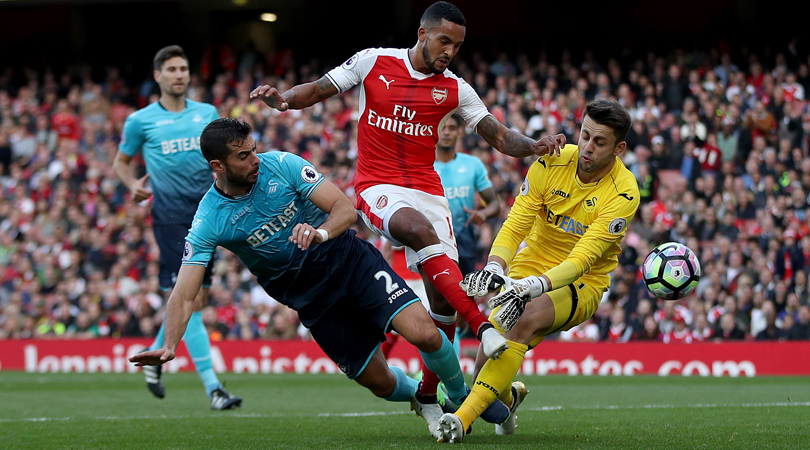
Few managers have pulled off back-three systems in the Premier League, but the weekend action hinted at a couple of exceptions. Three of the teams to feature in this review’s four selected games used three central defenders, and two of them won; had Manchester City known how to convert penalties, it would have been three out of three.
The most emphatic display came from Chelsea at home to Leicester, while Watford scraped a 1-0 win at Middlesbrough. At Arsenal, Theo Walcott embraced aspects of the central striker role to score twice and sink Swansea 3-2...
1. Koeman negates Pep’s 3-2-2-3
Pep Guardiola shelved his usual 4-1-4-1 system in favour of a kind of 3-2-2-3 at home to Everton on Saturday, but Ronald Koeman was prepared. The Dutchman, who played with Guardiola at Barcelona in the 1990s, sensed that Manchester City would use a back three and duly switched to a 4-3-3 in which three central midfielders screened the defence, while a speedy trio of Romelu Lukaku, Yannick Bolasie and Gerard Deulofeu threatened on the break.
We made absolutely everything today, we found the spaces, we reached the byline, we put in crosses, but nobody was there. Everton had once chance, but football can be like this
The way it played out, City had Raheem Sterling and Leroy Sané stretching play either side of Kelechi Iheanacho, while David Silva and Kevin De Bruyne lurked between the lines. The key change from the 4-1-4-1 was that City had two defensive midfielders dictating play and, since Gareth Barry, Tom Cleverley and Idrissa Gueye had enough trouble screening the backline, Fernandinho and Ilkay Gundogan were given plenty of time on the ball.
That invited pressure on the Everton defence, but the visitors allowed no big chances until Phil Jagielka tripped Silva inside the box, only for De Bruyne to miss the penalty. It also helped that Koeman moved his wingers inside before switching to a midfield diamond, which made it four versus four in the centre. The Toffees also retained a threat up front in Bolasie and Lukaku, and the two duly combined on the break to score the opener on 64 minutes.
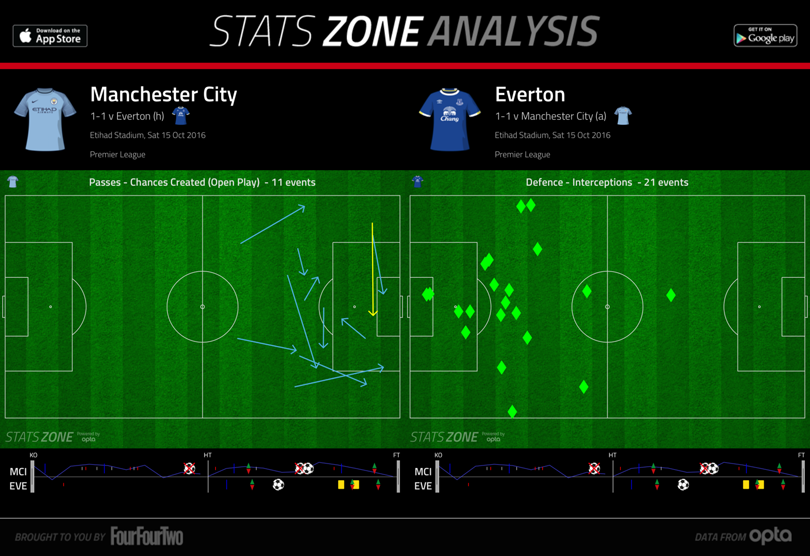
At the back, Everton made interceptions, blocks and clearances in and around the box to frustrate City. Even when Jagielka conceded a second penalty, this time on Sergio Aguero who’d come off the bench, Maarten Stekelenburg saved again and City needed another substitute, Nolito, to head in the equaliser. The draw disappointed City, but Guardiola took comfort in the dominance that the 3-2-2-3 had provided. “We made absolutely everything today, we found the spaces, we reached the byline, we put in crosses, but nobody was there,” he said. “Everton had once chance, but football can be like this.”
The best features, fun and footballing quizzes, straight to your inbox every week.
2. Chelsea blossom in 3-4-3
The assumption may have been that Hazard and Pedro would operate between the lines, but instead it was Costa who dropped deep and drew out the centre-backs so that the two wingers could run in behind
At Stamford Bridge, Antonio Conte retained the 3-4-3 system that sealed the 2-0 win at Hull and was rewarded with another convincing display. Leicester came with their usual 4-4-2 but struggled to contain the movement out wide: Victor Moses and Marcos Alonso would frequently find Diego Costa, Eden Hazard and Pedro, who would draw out defenders and return first-time passes down the flanks for the two wing-backs to run onto. One such combination between Costa and Moses created the corner from which Costa scored the opener.
Another aspect of the gameplan centred on Costa as a link-up player. The assumption may have been that Hazard and Pedro would operate between the lines, but instead it was Costa who dropped deep and drew out the centre-backs so that the two wingers could run in behind via flicks and one-twos.
The dynamic was apparent for the second goal, when all three were positioned close together, and the map of average positions later showed Costa being the deepest of the three. Hazard, who was the most advanced, recorded five attempts, whereas Costa had just one from open play.
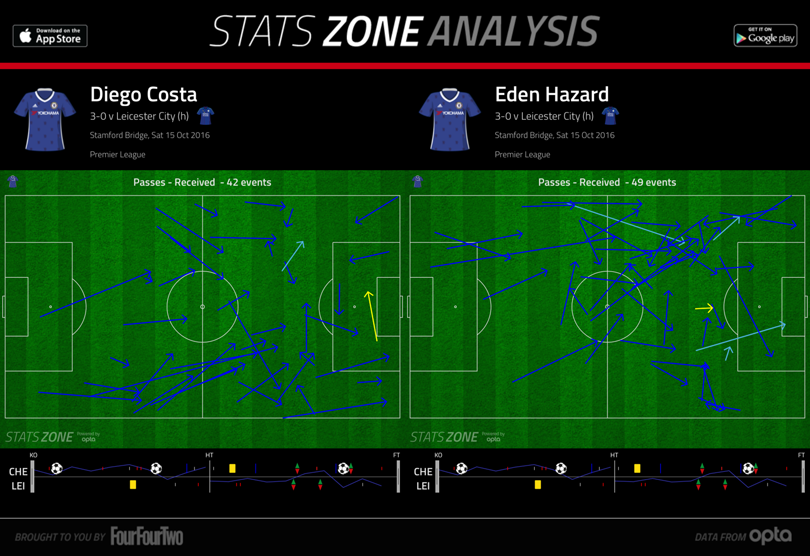
3. Walcott blends the best of two roles

STATS ZONE Free on iOS • Free on Android
In north London, Walcott continued his fine form with a brace. If there used to be a debate about whether he is better out wide or as a central striker, the 27-year-old has come to mix elements of both roles. Some of the moves here saw him make runs across the pitch to get into the box, while Hector Bellerin provided width on the right.
The best example was the opener, for which Walcott emerged in front of the defence, gave it to Alexis Sanchez and ran into the box to convert Bellerin’s headed cross. Arsenal later launched a counter-attack in which Walcott ran across the pitch to the left, while it was Mesut Ozil who sprinted down the right. Bellerin was also involved again and nearly finished off the move.
If that hadn’t emphasised Walcott’s instincts as a central striker enough, Arsene Wenger moved him up front towards the end when Arsenal defended in a 4-4-1 following Granit Xhaka’s dismissal. That led to two huge chances provided by Alex Oxlade-Chamberlain that he somehow missed. All in all, Walcott participated in build-up play on the right, while receiving key passes on the left.
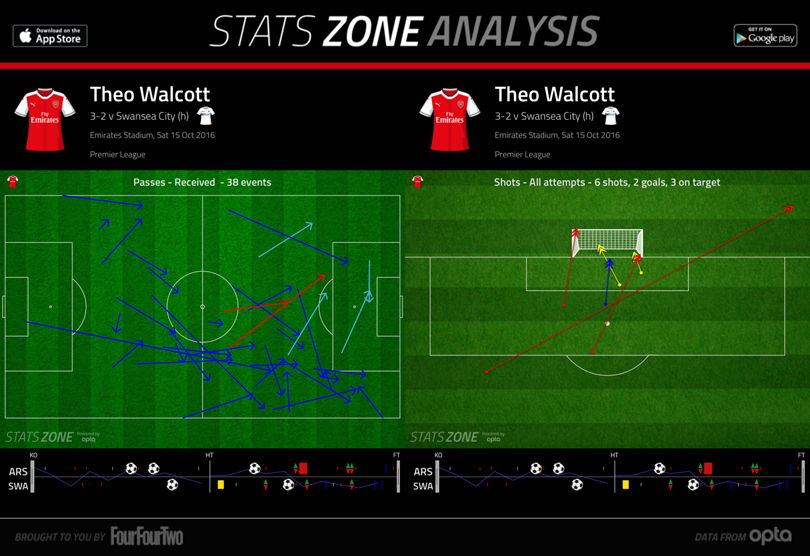
4. Cautious gameplan seals Watford win
Less excitement was on offer at the Riverside. Walter Mazzarri opted for a 5-4-1 system that seemed designed to shut down the hosts and nick a goal, and which gave the Hornets numerical superiority in the centre where three centre-backs marshalled Alvaro Negredo and closed down playmaker Gaston Ramirez. Out wide, wingers Isaac Success and Roberto Pereyra tracked the Boro full-backs, leaving Troy Deeney to fend for himself up front.
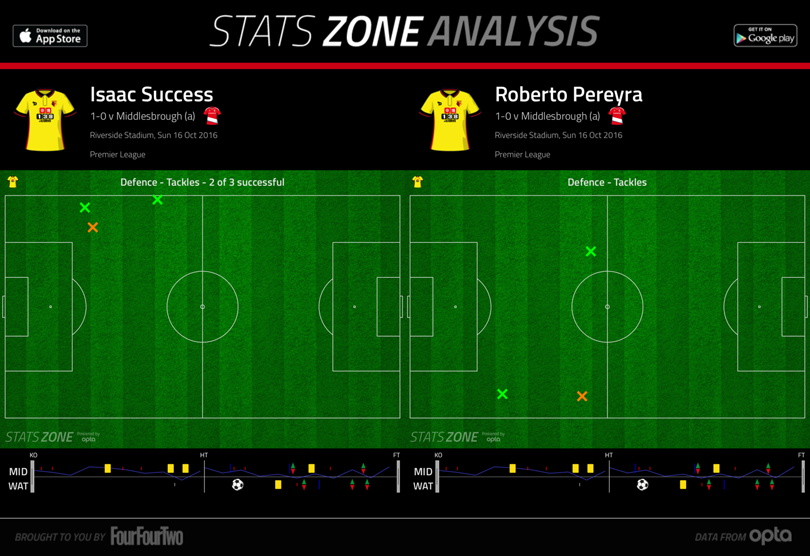
That was never likely to produce a thrilling game and neither did it help that Boro have been the best defensive side in the Championship in their two full seasons under Aitor Karanka. At half-time, there had been one attempt on target, and it was only apt that the winner came from a defender, Jose Holebas, after an interception. Not even Mazzarri was pleased with what he saw, despite the clean sheet and three crucial points.
STATS ZONE Free on iOS • Free on Android

